
a.
To find: The number of
a.
Answer to Problem 12PSB
There are eight triangles in the given figure.
Explanation of Solution
Given:
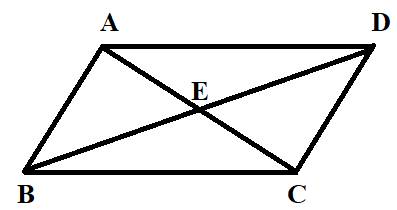
A parallelogram ABCD having diagonals AC and BD intersecting at E.
Concept Used:
Triangle is a three sided closed
Calculation:
Here, we have a parallelogram ABCD having diagonals AC and BD intersecting at E shown as
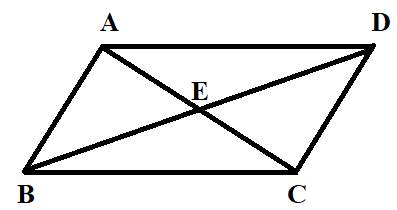
As we know that Triangle is a three sided closed polygon.
The triangles in the given figure are
Thus, there are eight triangles in the given figure.
Conclusion:
There are eight triangles in the given figure.
b.
To find: The number of
b.
Answer to Problem 12PSB
There are 12 angles in the given figure.
Explanation of Solution
Given:
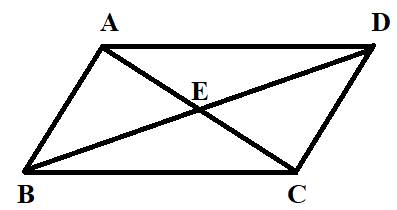
A parallelogram ABCD having diagonals AC and BD intersecting at E.
Concept Used:
Two lines passing through a single point known as vertex forms an angle.
Calculation:
Here, we have a parallelogram ABCD having diagonals AC and BD intersecting at E shown as
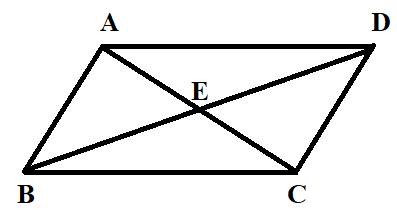
As we know that angle is formed when two lines passing through a single point known as vertex.
Angles in the given figure are
Thus, there are 12 angles in the given figure.
Conclusion:
There are 12 angles in the given figure.
c.
To find: The number of angles appears to be acute angle in the given figure.
c.
Answer to Problem 12PSB
There are 6 acute angles in the given figure.
Explanation of Solution
Given:
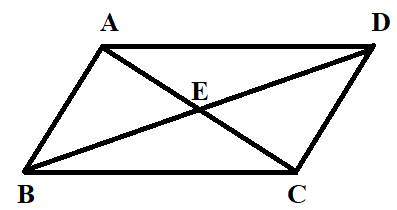
A parallelogram ABCD having diagonals AC and BD intersecting at E.
Concept Used:
Two lines passing through a single point known as vertex forms an angle. Acute angle is the angle whose measure is greater than zero degree but less than 90 degrees.
Calculation:
Here, we have a parallelogram ABCD having diagonals AC and BD intersecting at E shown as
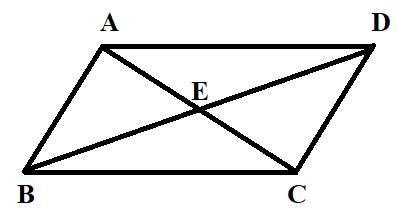
As we know that angle is formed when two lines passing through a single point known as vertex.
Acute angles in the given figure are
Thus, there are 6 acute angles in the given figure.
Conclusion:
There are 6 acute angles in the given figure.
d.
To find: The number of angles appears to be obtuse angle in the given figure.
d.
Answer to Problem 12PSB
There are 4 obtuse angles in the given figure.
Explanation of Solution
Given:
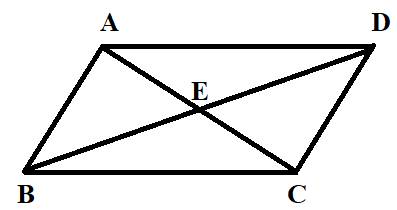
A parallelogram ABCD having diagonals AC and BD intersecting at E.
Concept Used:
Two lines passing through a single point known as vertex forms an angle. Obtuse angle is the angle whose measure is greater than 90 degrees but less than 180 degrees.
Calculation:
Here, we have a parallelogram ABCD having diagonals AC and BD intersecting at E shown as
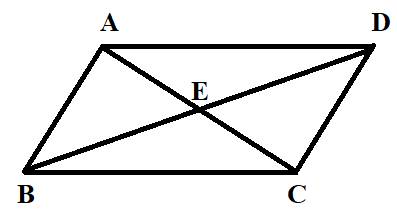
As we know that angle is formed when two lines passing through a single point known as vertex.
Obtuse angles in the given figure are
Thus, there are 4 obtuse angles in the given figure.
Conclusion:
There are 4 obtuse angles in the given figure.
e.
To find: The straight angles angle in the given figure.
e.
Answer to Problem 12PSB
Explanation of Solution
Given:
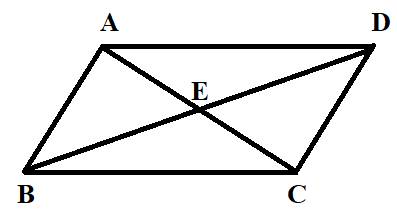
A parallelogram ABCD having diagonals AC and BD intersecting at E.
Concept Used:
Two lines passing through a single point known as vertex forms an angle. Straight angle is the angle whose measure is equal to 180 degrees.
Calculation:
Here, we have a parallelogram ABCD having diagonals AC and BD intersecting at E shown as

As we know that angle is formed when two lines passing through a single point known as vertex.
Straight angles in the given figure formed using the given diagonal, thus the straight angles are
Thus, there are two straight angles in the given figure.
Conclusion:
Chapter 1 Solutions
Geometry For Enjoyment And Challenge
Additional Math Textbook Solutions
A First Course in Probability (10th Edition)
Elementary Statistics: Picturing the World (7th Edition)
University Calculus: Early Transcendentals (4th Edition)
Algebra and Trigonometry (6th Edition)
- 39 Two sides of one triangle are congruent to two sides of a second triangle, and the included angles are supplementary. The area of one triangle is 41. Can the area of the second triangle be found?arrow_forwardA parallelogram with an area of 211.41 m^2 hast a base Thatcher measures 24.3m. Find ist height.arrow_forwardBH is tangent to circle A and DF is a diameter. I don't know where to go from here. May you help please?arrow_forward
 Elementary Geometry For College Students, 7eGeometryISBN:9781337614085Author:Alexander, Daniel C.; Koeberlein, Geralyn M.Publisher:Cengage,
Elementary Geometry For College Students, 7eGeometryISBN:9781337614085Author:Alexander, Daniel C.; Koeberlein, Geralyn M.Publisher:Cengage, Elementary Geometry for College StudentsGeometryISBN:9781285195698Author:Daniel C. Alexander, Geralyn M. KoeberleinPublisher:Cengage Learning
Elementary Geometry for College StudentsGeometryISBN:9781285195698Author:Daniel C. Alexander, Geralyn M. KoeberleinPublisher:Cengage Learning

